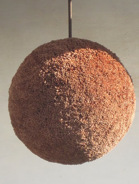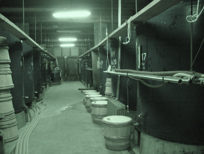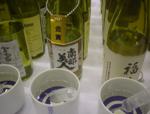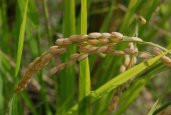|
|
Happy New Year to all!
Two-thousand-eleven is upon us. Amidst economic uncertainty,
trudging through quagmires of the uncertainties of our modern world and times, I wish you all health, happiness and prosperity in the coming new year.
Sake, too, faces its challenges. Despite sake’s increasing popularity around the world, “we’re not out of the woods yet.” Not even close. The industry is still in the thick of it, and will remain there until domestic appreciation, consumption and understanding of all things sake returns to appropriate, critical-mass levels.
Let us all do our part, enjoying sake and all it offers - responsibly, of course! - and let our enthusiasm be contagious.
The newsletter is slightly abbreviated this month to accommodate everyone’s busy holiday schedule. The omitted features (Did You Know and Sake Basics) will return next month.
Finally, there are exactly three (count ‘em!) seats available for the Sake Professional Course taking place this month from the 24th to the 28th. If interested, email me for details.
Renewed wishes for a great 2011,
John
 
|

The Suffix -shu
The commonly seen suffix -shu on sake-related words, especially
those related to grades, seems potentially confusing to some. As such, it is a -shu-in for the first topic of the year. Indeed, the -shu gets kicked around quite a bit, so it is time to put our foot down on it all.
Bad, bad puns notwithstanding, what is the truth behind all of this? Concretely speaking the various grades of sake are commonly seen in either one of two manifestations, for example junmai-shu or junmai, honjozo-shu or just honjozo, and ginjo-shu or just ginjo. Is there a difference? Is one more official? Is one more correct?
The shortest answer is no, there is no difference. And no, one is not more correct. Ginjo-shu and Ginjo are the same, as are honjozo-shu and honjozo, junmai-shu and junmai. The latter are just abbreviated versions of the former, the suffix being lopped off for simplicity.
What’s up with all of that? Well, the character for sake, 酒, can also be read -shu. In fact, almost all kanji characters used in the Japanese language have two (or more) readings, one being used in standalone readings and one in combinations with other characters. So sake and -shu are the main two associated with our beloved 酒 ideogram.
The meaning of the character is, in general, “alcoholic beverages.” So the word sake can mean both the rice-based brew of which we are so fond, but also - in the right context - alcoholic beverages in general. And it is included as a part of the grade names in order to give them relevance, i.e. junmai-shu is “pure rice sake,” futsuu-shu is “regular sake,” and honjozo-shu is “original brewing method sake.” But when there is sufficient context, it becomes almost superfluous, if not a bit of a bother. (Sake drinkers are essentially a lazy lot, it would seem.)
So it has become - if not optional - commonly dropped in most classifications. Sometimes it is used, and sometimes it is not. It’s nothing but a matter of ease and rhythm of pronunciation. And there is no rhyme or reason to it. So we might hear someone speak of a “ginjo-shu,” then in the next breath talk about a “junmai-ginjo,” and we sit there, waiting for the other -shu to drop. But, confusingly, it doesn’t. Don’t let it scare ya.
Wandering for a moment down a tangential path, the two official names for sa ke are seishu and nihonshu. Seishu means “refined sake,” and nihonshu means “Japan sake.” The name for the yeast starter, shubo, means “sake mother.” That dang -shu character is everywhere. All the grades (futsuu-shu, junmai-shu, honjozo-shu, ginjo-shu, junmai ginjo-shu, daiginjo-shu and junmai daiginjo-shu) share that same suffix. While it invariably remains intact for the two official names (as well as the class futsuu-shu), all the other grades commonly appear in both manifestations. ke are seishu and nihonshu. Seishu means “refined sake,” and nihonshu means “Japan sake.” The name for the yeast starter, shubo, means “sake mother.” That dang -shu character is everywhere. All the grades (futsuu-shu, junmai-shu, honjozo-shu, ginjo-shu, junmai ginjo-shu, daiginjo-shu and junmai daiginjo-shu) share that same suffix. While it invariably remains intact for the two official names (as well as the class futsuu-shu), all the other grades commonly appear in both manifestations.
Certainly, though, the longer forms are more official, being the legal terms used in official definitions. But in terms of everything else - what people actually say, and even what is written on labels - the terms are more or less interchangeable.
So in the end, just remember you do not have to use the -shu suffix. But you can if you like. So if the -shu fits, wear it.
|
 Announcements and Events Announcements and Events
Sake Professional Course 2011, Japan
January 24-28, 2011
"No sake stone remains left unturned."
CURRENTLY, THREE SEATS REMAIN OPEN. TIME IS RUNNING SHORT! PLEASE CONTACT ME ASAP IF YOU ARE INTERESTED IN THE MOST COMPREHENSIVE AND ENJOYABLE SAKE EDUCATION ON THE PLANET.
It is my pleasure to announce the 8th annual Sake Professional Course to be held in Japan. This is it, folks: the most important thing I do all year, and far and away the best possible sake education in existence. Three days of lecture and tasting, each evening capped off with dinner and fine sake, then two days spent visiting four sake breweries of different size and scale - punctuated again with fine sake and a great meal each evening. Of course, certification testing for a Certified Sake Professional is a part of the event.
Word travels fast, and as of today only eight (8) three (3) spots have already been reserved. If you are interested, please send an email to me at info@sake-world.com right away. Feel free to ask any and all questions or make any inquiries about the course as well. To learn more about the schedule and details, check this out.
Trust me when I say - for sake education - it does not get any better than this. Alternatively you can see what others have said.
Sake Tours!
Please join us for a very special journey through the regional
brewing and culinary traditions of Japan. Tour destinations are filled with moments you cannot experience otherwise. In 2011, we will return to San-in, the land of myth. And, we are adding a tour of the northern snow country of Akita for special breweries and onsen.
Meet and speak directly with artisans to appreciate their history, philosophy, and the art of brewing. Learn from the world's best sake educator, John Gaunter, and share the passion of brewers for their craft. Then, wind down at an onsen to relax, and simply have fun! Learn more at http://saketours.com . |
 Sake Education Central Sake Education Central
 Want to learn all the basic sake facts quickly? Just what you need to enjoy it immediately? Need neither too much nor too little information? Grab The Sake Notebook. Download it at 4pm and you will be ready to enjoy sake at dinner. Guaranteed!
The Sake Production Slideshow allows you to sit back, relax and watch a beautiful, condensed powerpoint presentation of how sake is produced.
Japanese for Sake Lovers not only teaches sake pronunciation, it includes a native speaker pronouncing the words with a time lapse for your practice. You not only learn how to speak “sake”, you learn proper Japanese pronunciation without the cost of a Japanese language course!
 Do you w ant to know the “behind the scenes” secrets of the master brewers? Read the untold stories of sake brewers in Sake’s Hidden Stories. Each of the dozen-odd stories introduces a brewer, the sake, and tons of subtle, hidden insights and sake information you'll not find in any other book about sake. Guaranteed. Do you w ant to know the “behind the scenes” secrets of the master brewers? Read the untold stories of sake brewers in Sake’s Hidden Stories. Each of the dozen-odd stories introduces a brewer, the sake, and tons of subtle, hidden insights and sake information you'll not find in any other book about sake. Guaranteed.
Going to Japan or a Japanese restaurant? Perhaps you’re in the mood for sushi and sake at home. Do you know what to look for and how to ask for it? You will when you tote around more than 200 terms in your pdf or iPhone with The Sake Dictionary.
Product Highlight: Japanese For Sake Lovers A Guide to Proper Pronunciation Here it is: something that ensures you will enjoy your sake experience more and more - a short, concise instructional guide on how to properly and naturally pronounce the Japanese language, sake brand names, and all the terminology that is a part of the sake world. With the help of this little course, you will sound like a native when talking about sake.
No more butchering sake names in Japanese! Learn how to properly pronounce the sake you love!
Japanese for Sake Lovers consists of a short text and three audio files. It all begins with a guide to the theory of pronouncing Japanese, which you will soon realize is surprisingly simple. Following that, you will have the opportunity to practice pronunciation of all the important terminology surrounding sake, and dozens of brand names that cement in your mind the principles, fundamentals, and idiosyncrasies of pronouncing Japanese.
This is not a language text. You will not learn grammar or much  vocabulary outside of sake-specific terms; although, it does include a handful of phrases to help you navigate your way to sake bliss in Japanese when at a sake pub. It is augmented by three audio files that allow you to practice, repeating the words and phrases after a native speaker. vocabulary outside of sake-specific terms; although, it does include a handful of phrases to help you navigate your way to sake bliss in Japanese when at a sake pub. It is augmented by three audio files that allow you to practice, repeating the words and phrases after a native speaker.
Go here now to order your copy for $14.99, and feel one step closer to the beverage you love – guaranteed.
*Satisfaction
Guaranteed*
Should any of the above products not be to your immense satisfaction, your money will be cheerfully refunded, no
questions asked.
|
Stay Subscribed!
Are you not getting this newsletter? I realize that is like asking that "those not present please raise your hand," but for future reference, should you spontaneously stop receiving this newsletter, please go here and sign up again. Should that not work, please go to www.sake-world.com.
Email newsletter services are very careful not to be considered spam enablers, but the problem is that often very valid email addresses come back bounced as invalid. It is an unavoidable problem. So if you or someone you know is not getting this, or stop(s) receiving it inexplicably, please do take a moment to double check that you are still subscribed.
Sincere apologies for the hassle, mixed with gratitude for reading this newsletter.
|
I hope you have found the above information helpful and entertaining. For more information about all things sake, please check out www.sake-world.com. Until next month, warm regards, and enjoy your sake. 
Questions and comments should be directed to John Gauntner, at this email address.
All material Copyright, John Gauntner & Sake World Inc.
Regards,
John Gauntner
Sake World, Inc
 . . 
|
|
